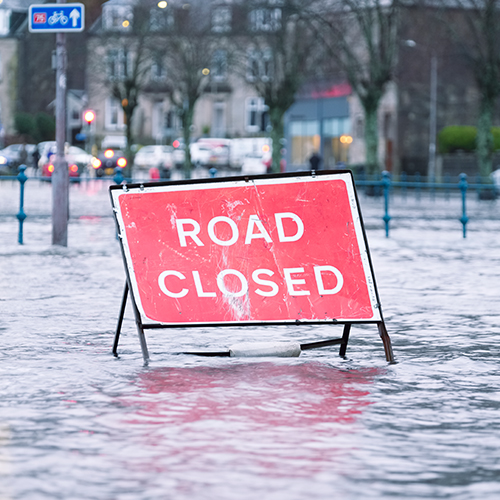As the climate crisis continues, severe weather is increasingly likely to pose problems for businesses. Taking precautions ahead of time can help mitigate losses in the future.
As well as increasing temperatures in parts of the globe to uninhabitable levels, climate change is leading to extreme weather events becoming more common. Intense cold snaps like 2018’s ‘Beast from the East’ can cause issues like burst pipes, as well as flash flooding leading to property damage and data loss, putting businesses at risk of serious financial loss. However, there are some things that can be done to mitigate such risks.
Flooding
Some areas of the UK are at much greater risk of flooding than others. To find out the risk level in your area, you can use the Environment Agency’s flood map, which divides the country into three zones based on how likely they are to flood - places in zone 1 present the lowest risk, while zone 3 denotes the highest risk. The map also shows rivers, water storage areas, and flood defence infrastructure.
The Environment Agency also offers an automated, 24-hour flood warning service. Signing up could give your business crucial time to prepare in the event of imminent flooding.
The next step is to have a documented flood plan available to all staff, including things like useful contacts, a map of service shut-off points, and the location of emergency supplies such as sandbags. It should also include a checklist of procedures that can be ticked off, including switching off gas and electricity supplies, and moving valuable equipment off the ground. It must be accessible to all staff, clear and easy to read.
In line with the adage to “fix the roof while the sun is shining”, there are plenty of practical steps you can take to help flood-proof your property. These might include:
- Choosing tiles rather than fitted carpets on the ground floor
- Ensuring electrical sockets, wiring and fuse boxes are least 1.5 metres above ground level
- Fitting water-resistant skirting boards
- Specially designed ‘Air Brick’ covers that are easy to place over ventilation bricks.
- Non-return valves to drains and water inlet and outlet pipes.
Cold weather
To reduce the chances of your premises reaching dangerously low temperatures inside, it’s worth trying to maximise the building’s energy efficiency. Sealing gaps around doors and windows and upgrading insulation may cost money in the short term, but these measures pay for themselves in energy savings.
Boilers are much more likely to break down during the winter when they’re most needed because that’s when they’re working hardest. Servicing your boiler (and having it repaired if necessary) is best done at the end of the summer, reducing the odds of a winter breakdown and a costly emergency call-out.
Perhaps the biggest risk of cold weather is the potential for burst pipes, which can leave your entire building unusable for days or even weeks in severe cases. There are some measures you can take to mitigate against this, however:
- Ensure your pipes are insulated with foam or rubber tubing
- Use the central heating system to ensure that the building temperature never dips below a certain level
- Ensure you know where the water stop tap is, so that leaking water can be stemmed in the event of a burst pipe
- If leaving the building vacant for a significant period of time, consider completely draining its water pipes and central heating system
Disaster recovery
Many SMEs don’t have disaster recovery plans in place, whilst even more organisations that lose access to their data for more than a week go out of business within a year. That’s why it’s crucial to have a plan and be prepared for the worst. Here are some things you can do:
- Back up data regularly, implementing both online and offline solutions, and ensure that it can be accessed away from your usual place of work
- Have an arrangement in place for remote working, should your usual premises be inaccessible
- Keep clients informed, ensuring they are able to reach you until operations return to normal
- Improved security and fire protection eg intruder and fire alarms
Insurance
There are three main types of insurance cover that can help protect your organisation against financial losses arising from extreme weather:
- Buildings and contents insurance normally covers disasters including flooding, storm, burst pipes, fire and theft
- Business interruption insurance covers loss of income or increased working costs that can arise from a disaster, e.g. renting temporary premises after a flood or fire
- Professional indemnity insurance protects against allegations of negligence, such as a client taking legal action to recover losses if a missed deadline caused by an extreme weather event costs them money.
Although there’s not much you can do to prevent extreme weather events themselves, taking the steps outlined above will ensure you’re as prepared as possible.
